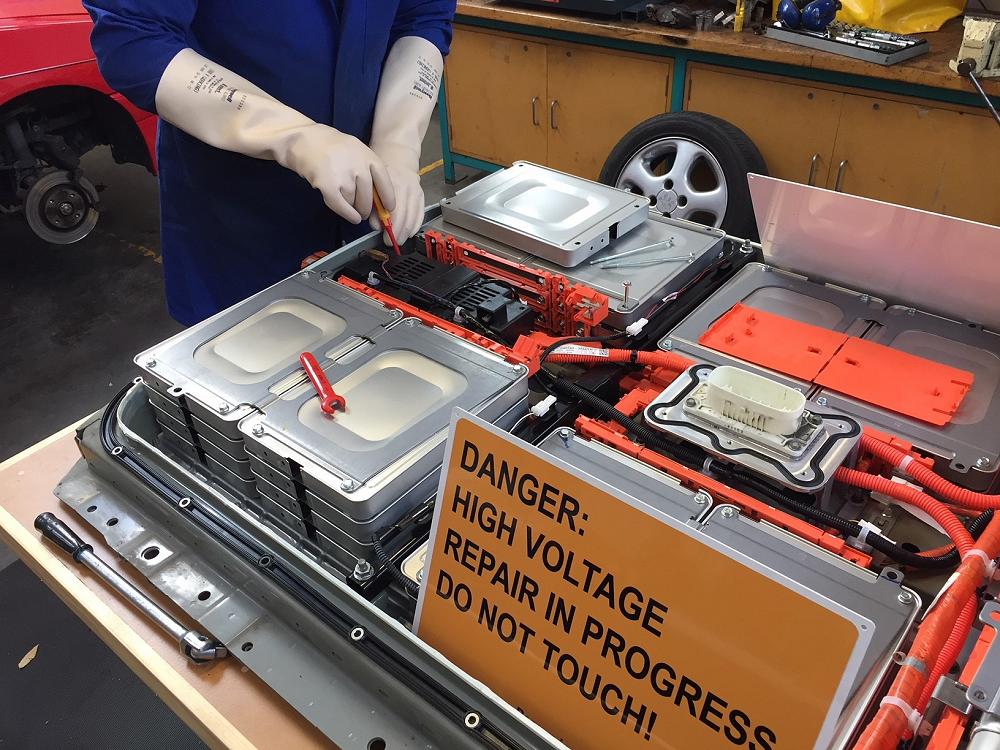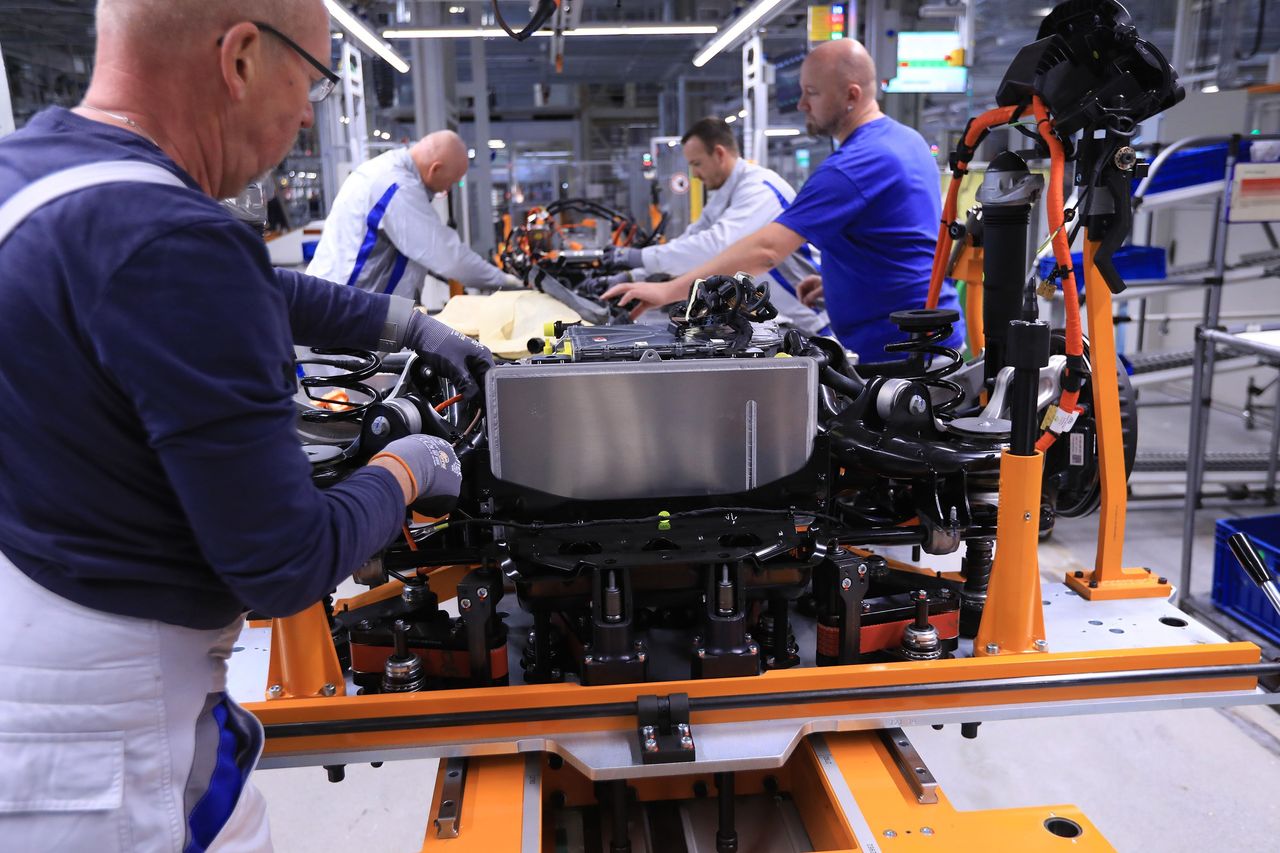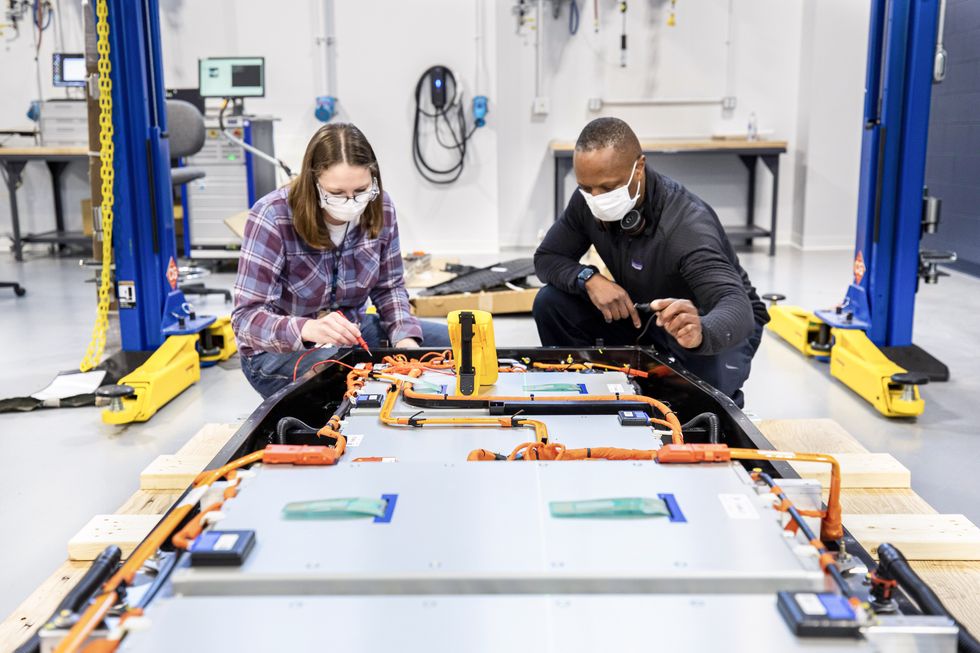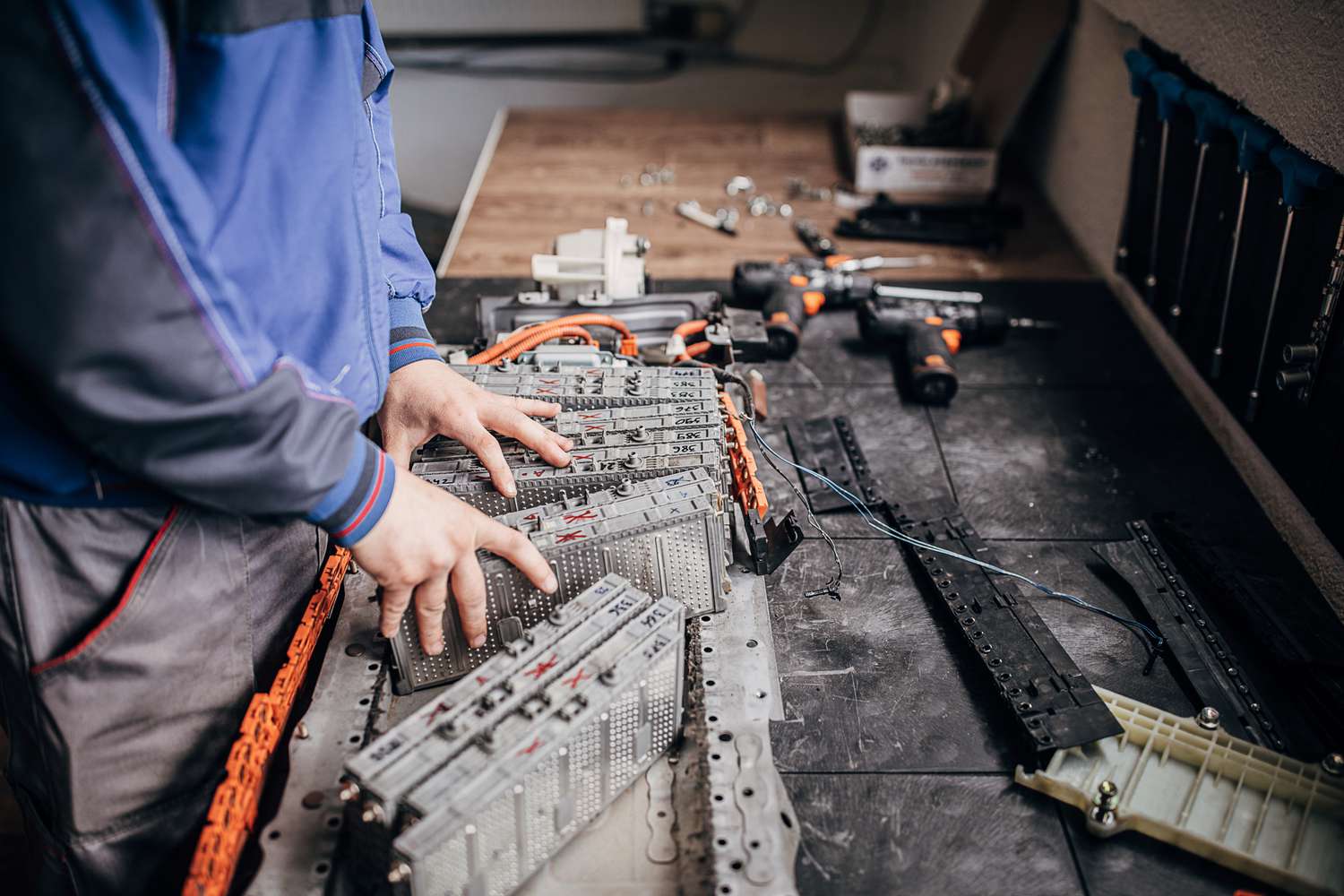Table of Contents
- 1 Is it Possible to Repair Damaged EV Batteries?
- 2 Understanding the Lifeline of Your Electric Vehicle: Battery 101
- 3 Should You Fix Your EV Battery Yourself or Hire a Professional?
- 4 A Professional’s Guide to Fixing EV Batteries
- 5 Choosing to Repair, Replace, or Recycle: What’s the Best Option?
- 6 Questions We Often Get Asked
- 7 Author

Key Points
-
EV batteries can often be fixed, especially if only certain modules are damaged.
-
Due to the complex and dangerous nature of battery systems, professional repair services are advised.
-
Regular upkeep and early problem detection can prolong the life of EV batteries.
-
Repairing an EV battery can be cost-effective, potentially saving about 50% compared to buying a new one.
-
Recycling and reusing EV batteries aids in environmental preservation and resource conservation.
Is it Possible to Repair Damaged EV Batteries?
The battery is the lifeblood of an electric vehicle (EV), powering it down the road. But what happens when that lifeblood falters, or worse, starts to fail? Many drivers are left wondering if a damaged EV battery spells the end for their cherished vehicle, or if there’s a chance for a comeback. Here’s the good news: In many cases, EV batteries can indeed be fixed, giving your vehicle a new lease on life.
Recognizing the Symptoms of EV Battery Damage
It’s important to be able to identify the signs of battery damage, much like recognizing the early symptoms of a cold so you can take action. Keep an eye out for:
-
Decreased distance capabilities
-
Diminished speed increase
-
Extended times to charge
-
Unreliable battery power indicators
Should you observe any of these signs, it’s an indication that you need to investigate further. These could be preliminary indicators that your battery requires maintenance.
Deciding on the Need for Repair: How to Determine the Severity of the Issue
It’s important to note that not every battery issue requires a complete repair. In some cases, the problem may just be routine maintenance. However, if you’re noticing serious performance problems, it would be wise to have a professional evaluate the situation. They can determine if the issue is a minor one that can be easily fixed or if it requires more comprehensive repairs.

Understanding the Lifeline of Your Electric Vehicle: Battery 101
We will start by understanding the basics of your EV’s battery. It is made up of many small cells and modules that work in harmony. If one module stops working, it doesn’t mean that the entire battery pack is done for. In many cases, replacing the faulty module is all it takes to get your vehicle running again.
Parts and How They Work
An EV battery is more than just a large energy source; it’s a sophisticated system. It consists of:
-
Single cells: these are the basic energy units
-
Modules: these are sets of cells bundled together
-
A battery management system (BMS): this is the brain that keeps track of and regulates the health of the battery
It’s important to understand these components because it helps you realize that a battery problem doesn’t always mean a complete system failure.
How Long Will It Last and How to Maintain It
Just like any other part of your car, your EV’s battery has a lifespan. It can last you a good number of years with the right care. Here are some tips to keep it running smoothly:
-
Don’t let your car sit in very hot or cold temperatures for too long.
-
Try to keep your battery’s charge between 20% and 80% to prevent overworking it.
-
Get your car checked out regularly to find and fix any problems as soon as possible.
Just by doing these easy things, you can help your battery last much longer.
Should You Fix Your EV Battery Yourself or Hire a Professional?
Fixing your EV battery isn’t a task you should take on yourself. Unlike changing a tire, EV batteries are high-voltage and complex. It can be hazardous if you don’t have the necessary training to handle them.
The Dangers of Repairing Batteries Yourself
Trying to fix an EV battery on your own can be a risky endeavor. Here are the reasons:
-
High voltage systems have the potential to cause severe harm or even fatality.
-
If you lack the appropriate tools and understanding, you might end up causing more damage.
-
Undertaking repairs yourself can result in the nullification of warranties and insurance policies.
Don’t take the chance. Always choose a professional repair service that employs certified technicians.
Getting Professional Help for EV Battery Issues
If you’ve chosen to go the professional repair route, the next thing you need to do is find a trustworthy service center. Look for ones that have certified technicians who are experts in EVs. They should have the right diagnostic tools to accurately identify the problem. Make sure to pick a service that supports their work with warranties on parts and labor.
Keep in mind, hiring a professional to repair your battery can save you money in the long run by making sure the job is done correctly and maintaining your battery’s lifespan. Plus, it’s a safer choice for both you and your car.

A Professional’s Guide to Fixing EV Batteries
What exactly happens when you bring your electric vehicle in to get the battery fixed? Let’s go through the process one step at a time.
Starting with a Diagnosis and Safety Measures
Every good technician will begin by diagnosing the issue. They’ll use specific tools to evaluate the condition of your battery and identify the source of the problem. Safety is a top priority, so they’ll also take measures to safeguard themselves and your car from the high-voltage system.
After they have determined what the problem is, they will talk to you about the repair plan, including the costs and how long it will take. It’s important to be transparent here; you should feel free to ask any questions and understand what’s going on.
Let’s say your EV is experiencing less range than usual. A technician might discover that one module is underperforming. They’ll inform you that replacing this single module could return your battery pack to full power.
Pinpointing the Issue: Module or Cell Replacement
Once the technician has identified the problem, they’ll figure out whether it’s with a single cell or an entire module. This is an important differentiation because it will impact how complex and expensive the repair will be.
-
If the damage is limited to a single cell, it might be possible to only replace that cell.
-
If the damage is to a module, the entire group of cells will need to be replaced.
Regardless, the aim is to rectify the issue with as little impact on the rest of the battery pack as possible.
Putting it Back Together and Testing After Repair
Once the bad parts have been replaced, the repair person will put your battery pack back together and run a bunch of tests. These tests are to make sure everything is working the way it should and that your battery is safe to use. They’ll check the battery management system to make sure it’s talking to the new parts the right way.
After they’ve completed the repair to their satisfaction, they’ll return your EV to you, often with tips on how to take care of your battery in the future.

Choosing to Repair, Replace, or Recycle: What’s the Best Option?
Once you’ve determined what’s wrong with your battery, you’ll need to decide if it’s best to repair it, replace it, or recycle it. This decision will depend on a few things:
-
How much damage has been done
-
How old your battery is
-
Whether it’s more cost effective to repair or replace it
If your battery is pretty new and it’s not badly damaged, it’s usually better to repair it. But if your battery is close to the end of its life or it’s really damaged, it might be cheaper in the long run to just replace it.
Another option is recycling, particularly for batteries that are irreparable. This is a choice that is good for the environment because it allows for the retrieval of valuable materials.
For example, by recycling your EV battery, you can make sure that materials like lithium and cobalt are recovered and used to make new batteries, which reduces the need to mine these resources anew.
Assessing the Cost-effectiveness of Battery Repair
Price is a major consideration when choosing between repair and replacement. Here are some things to think about:
-
Fixing a battery can be cheaper than purchasing a new one.
-
Some repairs might be covered by your car’s warranty.
-
A properly fixed battery can have a significantly prolonged lifespan, offering more bang for your buck.
Always request a detailed estimate and compare it to the cost of a new battery to make an educated choice.
How Batteries Affect the Environment
Once a battery has exhausted its life cycle, it needs to be disposed of. However, irresponsibly discarding an EV battery in a landfill is not just reckless, it’s hazardous. Batteries are made up of toxic substances that can seep into the soil and contaminate water sources. This is why it’s crucial to recycle or reuse them.
Opting to repair, recycle, or reuse your battery doesn’t just save you money, it also helps keep the planet clean. It’s a double win for your pocket and the environment.
Second Life: Repurposing EV Batteries
Even when an EV battery is no longer fit for the demands of road travel, it doesn’t mean it’s completely useless. Many batteries can lead a ‘second life’ in less demanding applications, such as stationary energy storage for homes or businesses. This is not only cost-effective but also environmentally beneficial, as it maximizes the use of the resources within the battery.
Companies are beginning to see the potential in this concept, developing creative ways to repurpose old EV batteries. So, before you discard your old battery, think about whether it might have another use.
|
No. |
EV Battery Producer |
|---|---|
|
1 |
Contemporary Amperex Technology Co., Ltd. (CATL) |
|
2 |
LG Energy Solution Ltd. |
|
3 |
BYD Co., Ltd. |
|
4 |
Panasonic |
|
5 |
SK Innovation |
|
6 |
Samsung SDI |
|
7 |
CALB (China Aviation Lithium Battery) |
|
8 |
Gotion High-Tech |
|
9 |
Automotive Energy Supply Corp. (AESC) |
|
10 |
Ruipu Energy Co. (REPT) |
These are the top 10 EV battery producers based on their market share and deployment in 2021.
Questions We Often Get Asked
What Issues Do EV Batteries Usually Have?
EV batteries can have a variety of problems, but some happen more often than others:
-
Decreased capacity that leads to a reduction in driving range over time
-
Power fade that results in slower acceleration and performance
-
Longer charging times due to the degradation of the battery
-
Cell imbalance which is when some cells wear out faster than others
By performing regular maintenance and monitoring, these issues can be caught early and the lifespan of your battery can be extended.

How Can I Tell if My Electric Car Battery Can Be Fixed?
When your electric vehicle battery starts acting up, the first thing you should do is get it checked out by a professional. They can examine the battery and let you know if it can be repaired. Typically, if only certain modules or cells are damaged, the battery can be repaired. But if the whole battery system is damaged, you may need to replace it.
How Much Does EV Battery Repair Typically Cost?
The price of EV battery repair can fluctuate significantly based on how much damage there is and the type and model of your car. On average, you might anticipate:
-
Replacing a cell will set you back a few hundred bucks
-
Expect to shell out thousands for a module replacement
-
You’ll need to fork over several grand for a full battery pack replacement
When you stack these prices up against the cost of a brand new battery, which can range from $5,000 to $15,000, it’s clear that repair is often the more wallet-friendly option.
Can a Fixed EV Battery Work Like It’s Brand New?
Definitely, an EV battery that’s been expertly fixed can work just as well as a brand new one, especially if the problem was confined to certain modules or cells. Once it’s been repaired, your battery should give you the range and performance you’re used to, although its total lifespan might be a little less than that of a brand new battery.
Can You Use Aftermarket Parts to Fix EV Battery Issues?
Yes, you can use aftermarket parts, such as third-party battery modules and management systems, which are usually cheaper than OEM (Original Equipment Manufacturer) parts. But you need to ensure that these aftermarket parts are compatible with your car and meet safety standards. You should always seek professional advice before choosing this option.





Leave a Reply